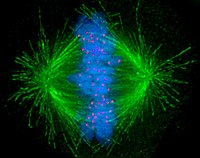
Photo from wikipedia
The excitation dynamics and self-oriented plasma coupling of a micro-structure plasma device with a rectangular cross-section are investigated. The device consists of 7 × 7 microcavity arrays, which are blended into a… Click to show full abstract
The excitation dynamics and self-oriented plasma coupling of a micro-structure plasma device with a rectangular cross-section are investigated. The device consists of 7 × 7 microcavity arrays, which are blended into a unity by a 50 μm-thick bulk area above them. The device is operated in argon with a pressure of 200 Torr, driven by a bipolar pulse waveform of 20 kHz. The discharge evolution is characterized by means of electrical measurements and optical emission profiles. It has been found that different emission patterns are observed within microcavities. The formation of these patterns induced by the combined action between the applied electric field and surface deactivation is discussed. The microplasma distribution in some specific regions along the diagonal direction of cavities in the bulk area is observed, and self-oriented microplasma coupling is explored, while the plasma interaction occurred between cross adjacent cavities, contributed by the ionization wave propagation. The velocity of ionization wave propagation is measured to be 1.2 km/s to 3.5 km/s. The exploration of this plasma interaction in the bulk area is of value to applications in electromagnetics and signal processing.The excitation dynamics and self-oriented plasma coupling of a micro-structure plasma device with a rectangular cross-section are investigated. The device consists of 7 × 7 microcavity arrays, which are blended into a unity by a 50 μm-thick bulk area above them. The device is operated in argon with a pressure of 200 Torr, driven by a bipolar pulse waveform of 20 kHz. The discharge evolution is characterized by means of electrical measurements and optical emission profiles. It has been found that different emission patterns are observed within microcavities. The formation of these patterns induced by the combined action between the applied electric field and surface deactivation is discussed. The microplasma distribution in some specific regions along the diagonal direction of cavities in the bulk area is observed, and self-oriented microplasma coupling is explored, while the plasma interaction occurred between cross adjacent cavities, contributed by the ionization wave propagation. The velocity of ionizat...
Journal Title: Physics of Plasmas
Year Published: 2018
Link to full text (if available)
Share on Social Media: Sign Up to like & get
recommendations!